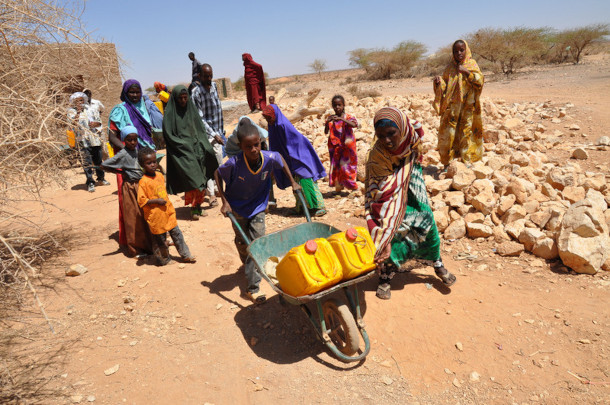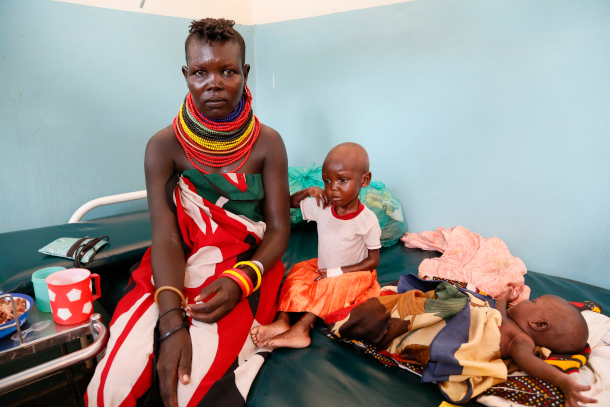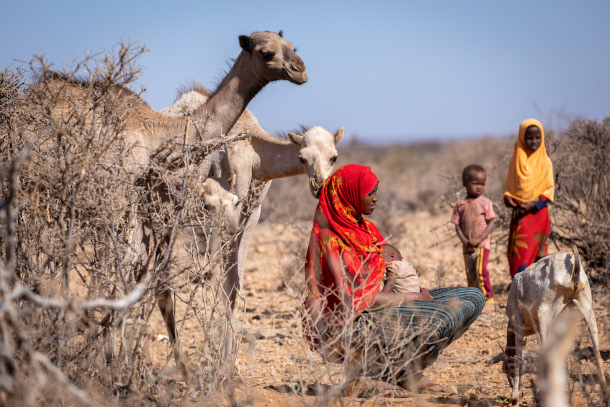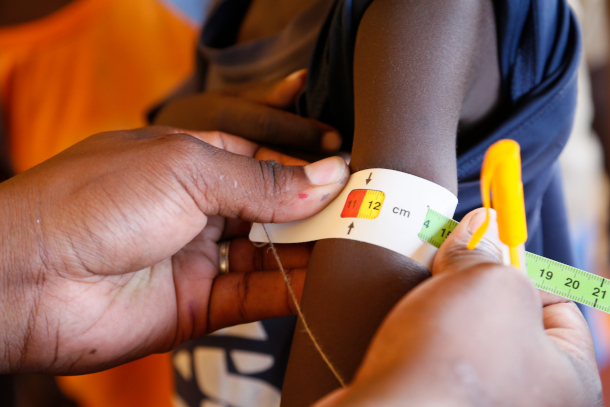Extreme Drought Causes Famine in East Africa
Air Date: Week of July 29, 2022

Faadomo Hirsi and her grandson wheel their daily water allowance of two 20-liter jerrycans back to their house in Somalia. (Photo: Alun McDonald, Flickr, Oxfam, CC BY-NC-ND 2.0)
A punishing drought in the Horn of Africa means farmers and pastoralists can no longer grow food locally and some 19 million people in Ethiopia, Somalia, and Kenya don’t have enough to eat. Aliow Mohamed, the Somalia Country Director with the NGO Islamic Relief Worldwide, joins Host Bobby Bascomb to shed light on the situation and how to help.
Transcript
BASCOMB: In the last decade, the Horn of Africa has experienced three severe droughts. The current drought has been going on for roughly two years. The countries of Ethiopia, Somalia, and Kenya haven’t had the seasonal rains that farmers and pastoralists depend on. The punishing drought has resulted in a severe food shortage; some 19 million people don’t have enough to eat. The region is in crisis amid starvation and malnutrition on a massive scale and millions of people are seeking help in IDP camps for internally displaced people. Scientists tell us that climate change is largely to blame and project the problem will only get worse in the future. Most of the region is expected to get hotter and drier in the coming decades. Aliow Mohamed is the Somalia Country Director with the NGO Islamic Relief Worldwide and joins me now for more. Aliow, welcome to Living on Earth!
MOHAMED: Thank you, Bobby, for having me. It's my pleasure.
BASCOMB: This is a region where irrigation really just isn't available at any scale. So, this lack of rain has been just devastating for agriculture. Can you tell us about that please?
MOHAMED: People here are dependent on livestock, their livelihoods are mainly on livestock, on farming. And with four consecutive rains having failed, then, of course, animals have died. No places for farming, I mean, there's no farming. So basically, the buildup of the failure of rainfall has resulted to catastrophic status where people are now food insecure, where people are now dying because of starvation, where people and animals have died because of lack of water. And people are now heading to the IDP camps where maybe NGOs like Islamic Relief and other organizations are providing support. So these are the people who have just abandoned forcefully, not by will, but forcefully, by the circumstances, their livelihood, and now ending up begging, and even losing some of their childrens and you know, the everything.
BASCOMB: I've read that close to 19 million people across the Horn of Africa are experiencing food insecurity and malnutrition. I think you know, for a lot of our listeners, that number is just hard to wrap your mind around, it's hard to imagine that much suffering. You've traveled across the region. Can you tell us please, what does that really mean? What does that really look like on the ground?

Two-year-old girl Erukudi, her mother Helen and baby sister, pictured in Lodwar Hospital, Turkana County, Northern Kenya. Erukudi is suffering from severe acute malnutrition and is being treated with a high-energy milk formula to help her regain weight. (Photo: Russell Watkins, Flickr, DFID, CC BY 2.0)
MOHAMED: I think 19 million is just the data we have up to date, the number will continue increasing. And most likely, by the end of the year, we might be hitting 30 million basically, you know, if not more. And of course, the region that is most suffering currently is Somalia and Ethiopia. And in Somalia, basically, the situation is really, really worse due to weak government, prolonged conflict. And all these things have contributed to the number just increasing. For example, in Somalia, we are talking of closer to 7 million people food insecure, almost 3.5 million people are in displaced camps. And close to 1.6 million children are malnourished. And closer to 6.5 million people have no access to water.
BASCOMB: Yeah, I just, how do people manage? How do people deal with that? I understand that millions of people have had to leave their homes against their will, as you point out, they're in displacement centers and refugee camps and that sort of thing. Can you describe that for us, describe the journey that people are taking to these places to seek some semblance of health and safety? What do those camps look like?
MOHAMED: Actually, two weeks ago, I was in one of the biggest camps in southwestern states in Somalia, in a place called Baidoa. This camp hosts closer to 500,000 people. And the time we visited, we met with a mother with her five kids. And out of five kids, three, she left with the father and she managed to come with two. And she told us she traveled almost for seven days with no food, no water. And she was lucky at least that she has reached that camp. And even that camp, she will not be able to get food or even water or even any support because as the number increases, the few NGOs who are providing the supports are overstretched. So the new people who are coming or the new groups who are coming from their homes, coming to look for source of livelihood, are not able to get an immediate support. So sometimes they can even stay within the camp for two or three days without maybe getting any support. And sometimes the good thing is the Somalis, you know they have this culture of sharing. So maybe if an NGO is giving a food commodity, maybe of 10 kg of rice, or 10 kg of wheat flour, then they split up and they share this. And this mother was telling us and she's heavily pregnant, she was actually nine months pregnant, and she has to travel all that. And she said some times along the road there are hyenas, there are you know a number of wild animals, whom she has to make sure that you know her children are covered. And the good thing is at least there was a group of them, but they have lost along the way some of their people whom they left together from their villages, going for those seven days to those camps. So the camp, coming to the status of the camp. There are no health facilities, no washing facilities, maybe latrines or even there is no basic shelter, no places for them to sleep. So they're just making up some makeshift, you know, with a tattered cloths on top, and their childrens are just sleeping under these. It's really very, you know, heartbreaking situations. When food is basically human rights, people are starving because of lack of food, people are starving because of lack of water. It's really, it's really touching and that is the kind of situation you know, that we have in the camps.
BASCOMB: Wow. That is a heartbreaking story that you share with us. What kind of resources are you seeing from the international community? It sounds like not nearly enough, obviously. But what's happening there that there's such this dramatic shortfall?

Zaynab Wali, a mother of seven children, used to sell some of her goats to supplement her income. But she lost almost half the goats to the current severe drought in Saglao village in Ethiopia. (Photo: Mulugeta Ayene, Flickr, UNICEF Ethiopia, CC-BY-NC-ND-2.0)
MOHAMED: You know, usually every year through the United Nation, international NGOs come together and there's what we call the Humanitarian Response Plan. And these response plan usually have a target, for example, the one for Somalia is $1.5 billion, that can be able at least to take care of this crisis. But up to now, only 16 to 20% have been committed. And you know, we almost the years almost ending, and the need is too much. So basically, the plan has been set, the response plan has been done with clear targets of what needs to be done in terms of food, in terms of health, in terms of water, to be provided to these people, but then the international communities are not coming on board as much as it is required to fulfill this obligation.
BASCOMB: Now, the drought in the Horn of Africa that we've been talking about is arguably the most acute case of agricultural collapse in the world right now. But we're also seeing extreme heat events in India that have affected the crops there, here in the US, you know, we have fire, droughts, floods that are impacting what we can grow, and of course, the war in Ukraine has led to a shortage of many grains. These shortages are inherently driving up the cost of food. What are you seeing there in terms of the cost of food? I mean, you can't grow your own, because there's just no rain, and importing it has to be that much more expensive.
MOHAMED: Yes, I think that is very, very true. In Somalia, basically, most of the food commodities are being imported. And I think most of the wheat because it's basically more of like a staple food for Somalis. And with the war in Ukraine, of course, the price has escalated. And of course, the impact of the COVID as well. I have an example where recently we contracted a supplier to provide food ration for six months. We booked like a supplier for six months to supply a ration to 600 households. Initially, when we budgeted it was one household per month was $60. And after one month, it jumped to $80. And this guy just delivered one, one ration and then second month, he come back to us and he said, you know, you have to increase it by $20 for me to be able to supply the food. And he said this is just for this month and next month, we don't know what will happen. And we have to now, you know, put on hold, discuss with the donor. And what happened is now we have to cut the ratio of the number of the people now we are targeting. You can imagine initially you targeted 600, now you reduced to 400, because the other 200 now cannot be able to be catered for. So these are the impact of the Ukraine conflict is actually biting and we are feeling it right in the field where we are providing this support to the people who are in the camps.
BASCOMB: What can anyone do who's listening to us? You know, I think the story is so heartbreaking that it's just, you know, people want to help, but what can the average person listening to us do to be helpful?

International Rescue Committee staff measure the upper arm circumference of 7-year-old Ngikadelio Ngikeny as part of a malnutrition screening program, at a health clinic in Turkana County, northwest Kenya, 29 March 2017. (Picture: Russell Watkins, Flickr, DFID, CC BY 2.0)
MOHAMED: For example, for us, Islamic Relief food is very critical at this point in time. We need health, we need medicine, because within the IDP camps children are, you know, suffering from respiratory, suffering from skin diseases, suffering from wasted bodies, and you know, suffering from all sorts of illness. Elderly people are dying due to lack of water, so therefore, we need water. So those are the three critical basic thing that we need, so that we can be able to stop or mitigate famine, or mitigate people from dying in mass, as it has happened in 2011. When the donors only come in, money only come after people have already perished. You know, we don't want to reach that level. We have seen in a camp for example, in one of the camp, we saw closer to 70 children died in one month, you can imagine, in one month. And that was just in June, not even July. I mean every other month, things just get more severe and worse as the time goes. So, even a small amount of money that is directed to save one household, I mean is very important at this point than any other thing.
BASCOMB: Aliow, you know, this situation in the Horn of Africa is just heartbreaking but you still show up every day and you're still working so hard for the people of the region. What gets you out of bed every morning? What still gives you hope?
MOHAMED: That's a very good question. Sometimes you go to the field and you just become emotional. You know, if you know that a mother with her children have not had food for the last four days, you know, a child of 3 years old, a child of you know 5 years old. But I think, you know, the hope we have is at least, I mean, we just go and tell them, you know, that we are here, you have not been abandoned, we are trying to reach out to the other parts of the world, so that we can be able to come and support you. Human being like me and you, I mean, we have to feel for one another. And you just can't see your fellow human being perish, you know, due to lack of food, due to lack of just basic commodities. I mean, it's more of like a call, so where you have to go and you know, support this community as much as you can.
BASCOMB: Aliow Mohamed is the Somalia Country Director at Islamic Relief Worldwide. Aliow, thank you so much for sharing these stories with us today and for all of your hard work.
MOHAMED: Thank you very much, Bobby for having me.
BASCOMB: If you’d like to help the people of East Africa, visit the Living on Earth website, loe.org, where we will link to organizations that are providing aid, including Islamic Relief World Wide, the World Food Program, and others.
Links
World Meteorological Association | “Drought Tightens Grip in Eastern Africa”
CBC | “Water Scarcity and Drought in East Africa Are 'Everybody's Problem,' Says UN Scientist”
International Rescue Committee (IRC)
Living on Earth wants to hear from you!
Living on Earth
62 Calef Highway, Suite 212
Lee, NH 03861
Telephone: 617-287-4121
E-mail: comments@loe.org
Newsletter [Click here]
Donate to Living on Earth!
Living on Earth is an independent media program and relies entirely on contributions from listeners and institutions supporting public service. Please donate now to preserve an independent environmental voice.
NewsletterLiving on Earth offers a weekly delivery of the show's rundown to your mailbox. Sign up for our newsletter today!
 Sailors For The Sea: Be the change you want to sea.
Sailors For The Sea: Be the change you want to sea.
 The Grantham Foundation for the Protection of the Environment: Committed to protecting and improving the health of the global environment.
The Grantham Foundation for the Protection of the Environment: Committed to protecting and improving the health of the global environment.
 Contribute to Living on Earth and receive, as our gift to you, an archival print of one of Mark Seth Lender's extraordinary wildlife photographs. Follow the link to see Mark's current collection of photographs.
Contribute to Living on Earth and receive, as our gift to you, an archival print of one of Mark Seth Lender's extraordinary wildlife photographs. Follow the link to see Mark's current collection of photographs.
 Buy a signed copy of Mark Seth Lender's book Smeagull the Seagull & support Living on Earth
Buy a signed copy of Mark Seth Lender's book Smeagull the Seagull & support Living on Earth

